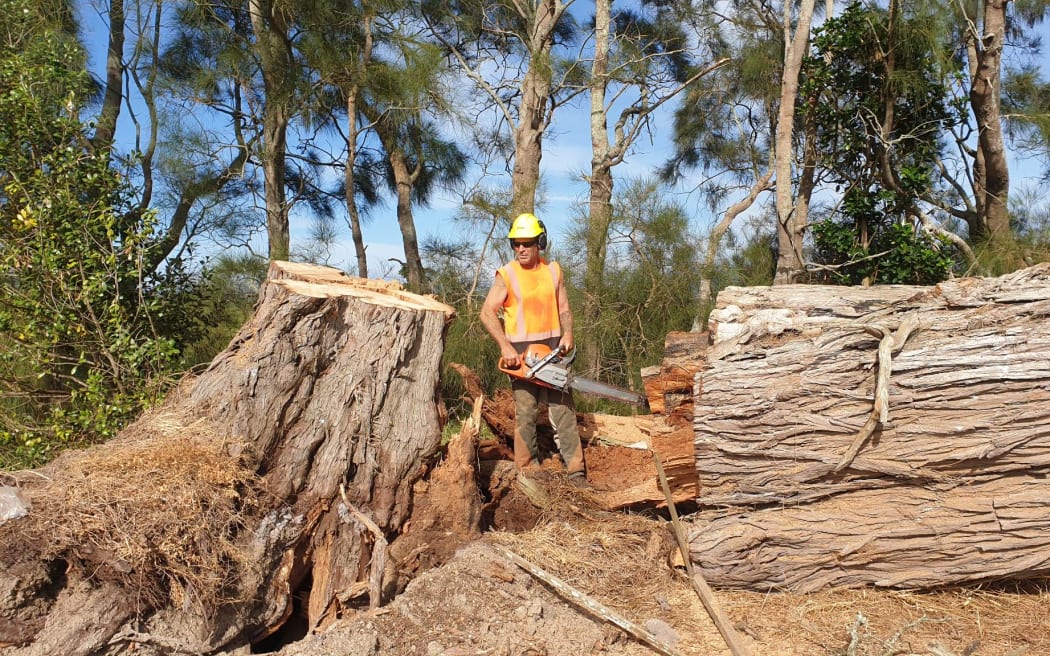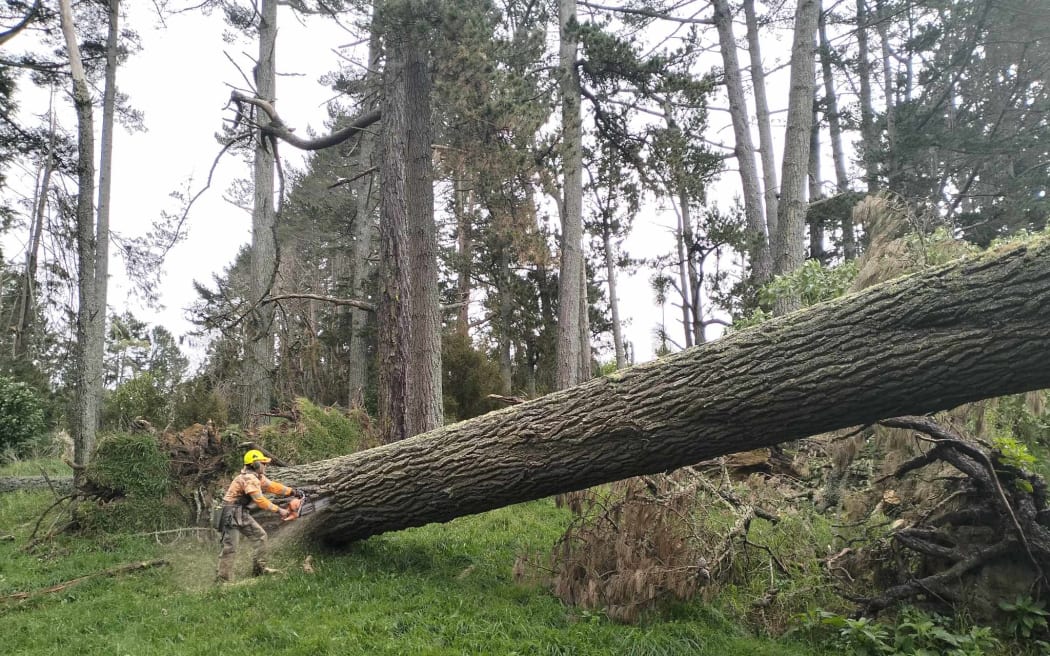
Kaimahi Verran Hita making short work of fallen macrocarpa on a Turiwiri Dargaville farm where he was involved with recent Enhanced Taskforce Green Cyclone Gabrielle mahi. Photo: Supplied / Te Roroa
Hundreds of thousands of Northland's Cyclone Gabrielle-downed trees are in for the chop in a unique $6.5 million resilience project aimed at slashing the chances of the region enduring major severe weather power and phone failures.
The project will also provide firewood for in-need families.
Te Tai Tokerau was debilitated during the February cyclone, with 64,000 Northlanders without power and widespread phone failures.
Northland Civil Defence Group recovery manager Mark Trudinger said the region's hugely-hit roads bore the biggest overall cyclone impacts. Downed trees were such a significant issue they had identified as the second biggest major impact that needed sorting for future post-cyclone resilience.
Trudinger said trees falling onto power lines, rather than network outages, had been revealed as the major power loss cause in more than 90 percent of power failures. Power loss also resulted in Northland's biggest regional phone network failure. Widespread impacts included to food storage, cooking and heating.

He said the major impact from cyclone-hit trees in Northland - causing power outages, phone failures, flooding, access issues and more - had not been experienced in the same way by New Zealand's other Gabrielle-impacted regions.
The collaborative Ngā Manga Atawhai (caring branches) project - run on the ground by Northland west coast Iwi Te Roroa - will be officially launched at a pōwhiri on 8 September at Te Whakamaharatanga Marae, Waimamaku on Northland's remote west coast.
A key feature of the $6.5m project is that recovered trees will be turned into firewood for eligible in-need families. The wood will be dropped off to local community depots, including marae, and distributed from there.
Trudinger said Ngā Manga Atawhai would therefore go some way to reducing energy poverty.
"We found as a result of the cyclone that many Northlanders have wood burners, but they don't have firewood," he said.

Kaimahi Verran Hita chopping up one of more than 1000 Cyclone Gabrielle-hit fallen trees during a recent six-month Enhanced Taskforce Green Cyclone Gabrielle mahi stint around Northland and beyond. Photo: Supplied / Te Roroa
A portion of the firewood will be sold to cover costs and towards making the mahi a long-term permanent kaupapa.
The multi-purpose project, clearing dangerous cyclone-damaged trees with firewood for eligible in-need families, is thought to be nationally unique in New Zealand's Gabrielle-hit regions.
It has grown out of Te Roroa's preceeding Enhanced Taskforce Green clean-up of more than 1000 cyclone-hit trees from West Auckland's Swanson to Houhora in the Far North over the last six months.
A funding application towards Ngā Manga Atawhai's full $6.5m two-year project set up and running cost is currently before Cabinet - this includes towards potentially funding a Far North-based equivalent. It has attracted $1m funding to date.
Trudinger said Ngā Manga Atawhai would also see rangitahi and out-of-work forestry kaimahi (workers) trained.
It was also expected to reduce flood risk through removing cyclone-hit trees from rivers and improving soil's consistency and ability to retain water through spreading trees' chipped nutrient-rich treetops across paddocks.
Northland west coast iwi Te Roroa will lead on-the-ground delivery of the resilience project, out of its Waipoua headquarters.
Te Roroa commercial operations manager and on-the-ground project lead Lindsay-Jon Clark said many of the Gabrielle issues Northlanders experienced were due to fallen trees, which still remained under existing powerlines or next to roads and rivers - along with thousands of standing trees still at risk of falling over roads, rivers and powerlines.
Clark said Ngā Manga Atawhai increased Northland's resilience while ensuring harvested wood did not go to waste. It aimed to build Northland's capacity to better withstand and recover from major weather events such as Cyclone Gabrielle into the future.
Clark said an about dozen-strong team of kaimahi (workers) would be doing the tree clearance and timber harvesting work. This mahi was expected to be done on affected private farmland as well as affected local marae.
Much of Ngā Manga Atawhai's initial work will be processing trees already removed by NRC from 70 locations across 25 Northland rivers.
The collaborative project pulls together groups from across Northland councils, government, iwi and the private sector to enable the dangerous trees' removal.
Those involved include Northland Civil Defence Emergency Management Group, Te Roroa Commercial Development, NRC, Kaipara District Council, Far North District Council and Whangārei District Council, Te Kahu O Taonui (Northland Iwi Chairs Forum), Northpower, Top Energy, Waka Kotahi NZTA, Northland Transportation Alliance, Rural Support Trust, Manawa Ora Healthy Homes Initiative (Te Whatu Ora), Ministry of Social Development, Ministry for Primary Industries plus Ministry for Business, Innovation and Employment.
Local Democracy Reporting is Public Interest Journalism funded through NZ On Air

